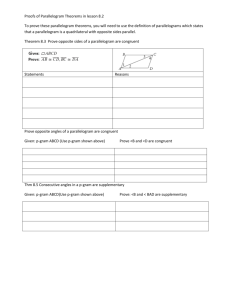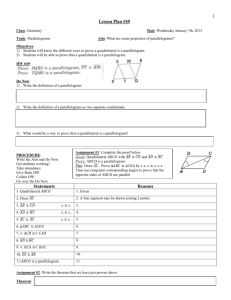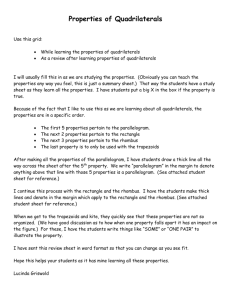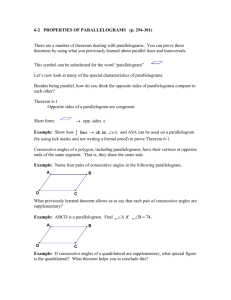Unit 5 Review Stations
advertisement
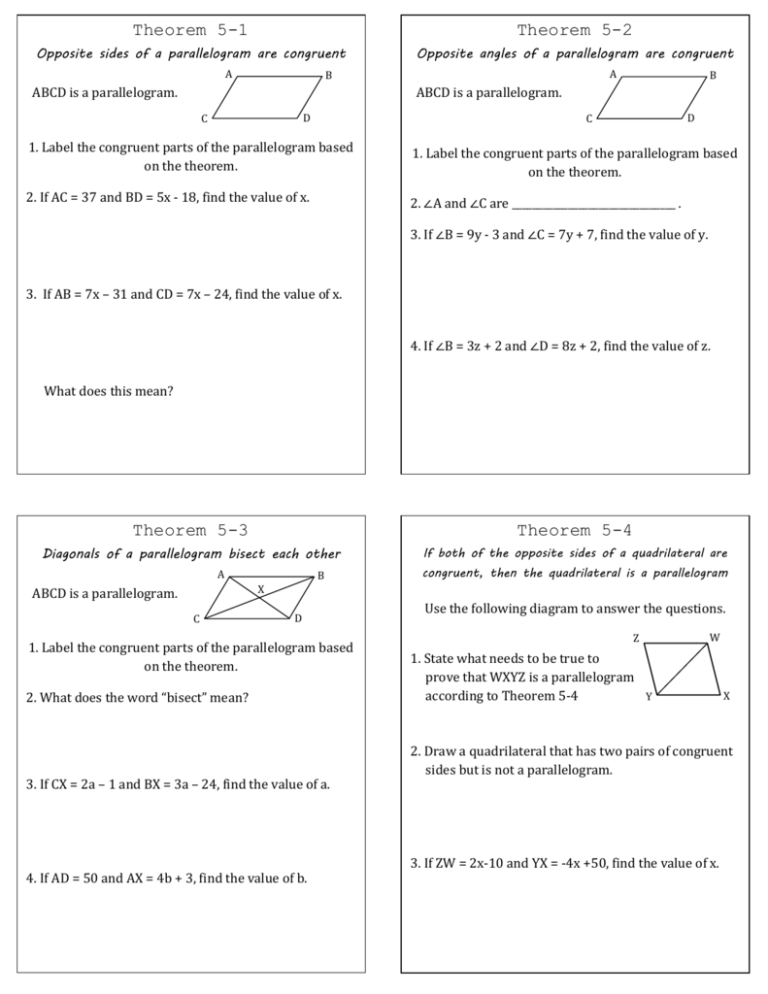
Theorem 5-1 Theorem 5-2 Opposite sides of a parallelogram are congruent Opposite angles of a parallelogram are congruent A A B ABCD is a parallelogram. B ABCD is a parallelogram. D C D C 1. Label the congruent parts of the parallelogram based on the theorem. 1. Label the congruent parts of the parallelogram based on the theorem. 2. If AC = 37 and BD = 5x - 18, find the value of x. 2. ∠A and ∠C are ________________________________ . 3. If ∠B = 9y - 3 and ∠C = 7y + 7, find the value of y. 3. If AB = 7x – 31 and CD = 7x – 24, find the value of x. 4. If ∠B = 3z + 2 and ∠D = 8z + 2, find the value of z. What does this mean? Theorem 5-3 Theorem 5-4 Diagonals of a parallelogram bisect each other If both of the opposite sides of a quadrilateral are A B congruent, then the quadrilateral is a parallelogram X ABCD is a parallelogram. C D 1. Label the congruent parts of the parallelogram based on the theorem. 2. What does the word “bisect” mean? 3. If CX = 2a – 1 and BX = 3a – 24, find the value of a. 4. If AD = 50 and AX = 4b + 3, find the value of b. Use the following diagram to answer the questions. Z W 1. State what needs to be true to prove that WXYZ is a parallelogram according to Theorem 5-4 Y X 2. Draw a quadrilateral that has two pairs of congruent sides but is not a parallelogram. 3. If ZW = 2x-10 and YX = -4x +50, find the value of x. Theorem 5-5 Theorem 5-6 If one pair of opposite sides of a quadrilateral is both If both pairs of opposite angles of a quadrilateral are congruent and parallel, then the quadrilateral is a congruent, then the quadrilateral is a parallelogram parallelogram Use the following diagram to answer the questions. Use the following diagram to answer the questions. W Z W Z 1. State what needs to be true to prove that WXYZ is a parallelogram according to Theorem 5-4 1. State what needs to be true to prove that WXYZ is a parallelogram according to Theorem 5-4 Y X X Y 2. Draw a quadrilateral that has one pair of congruent sides and one pair of parallel sides but is not a parallelogram. 2. Draw a quadrilateral that has two pairs of congruent angles but is not a parallelogram. 3. If ∠WYX = 100° and ∠ZWY = 4y, find the value of y. 3. If ∠Z = 20z + 10 and ∠X = 30z – 10, find the value of z. Theorem 5-7 Theorem 5-9 If the diagonals of a quadrilateral bisect each If three parallel lines cut off congruent segments on other, then the quadrilateral is a parallelogram one transversal, then they cut off congruent segments on every transversal Use the following diagram to answer the questions. W Z 1. State what needs to be true to prove that WXYZ is a parallelogram according to Theorem 5-4 O Y 2. Draw a quadrilateral that has two congruent diagonals. X 1. If AC = 30, find the value of BC. 2. If XY = 22, find the value of XZ. 3. If XY = 2t – 3 and YZ = 3t – 26, find the value of t. 3. If ZX = 30 and OZ = 2x – 7, find the value of x. 4. If BC = 2g + 6 and AC = 5g – 5, find the value of g. Theorem 5-10 Theorem 5-11 A line that contains the midpoint of one side of a The segment that joins the midpoints of two sides of triangle and is parallel to another side passes through a triangle the midpoint of the third side 1. is parallel to the third side 2. is half as long as the third side 1. If AN = 6, find AC. 1. If BC = 20, find MN. 2. If m∠ANM = 3x – 4 and m∠NCB = 29, find the value of x. 3. If AB = 96 and AM = 3k + 12, find the value of k. 4. If AN = 2j – 8 and NC = j + 11, find the value of j. 2. If m∠AMN = 4i + 4 and m∠MBC = 5i - 3 , find the value of i. 3. If AC = 9d and NC = 5d – 2, find the value of d. 4. What do we know about the angles of ∆𝐴𝑀𝑁 𝑎𝑛𝑑 ∆𝐴𝐵𝐶? Theorem 5-12 Theorem 5-13 The diagonals of a rectangle are congruent The diagonals of a rhombus are perpendicular Theorem 5-16 Theorem 5-14 If an angle of a parallelogram is a right angle, Each diagonal of a rhombus bisects two angles of the rhombus then the parallelogram is a rectangle J K Theorem 5-17 If two consecutive sides of a parallelogram are congruent, then the parallelogram is a rhombus N Q M L R T 1. If JL = 2x + 7 and MK = 5x – 35, find the value of x. P 2. If MN = 2x + 2 and MK = 5x – 5, find JL. S 1. If m∠QTR = 5v, find the value of v. 2. What type of triangle is ∆𝑄𝑅𝑆 ? 3. Label all congruent segments on the diagram above. 4. List all sets of congruent triangles. 3. What type of triangle is ∆𝑃𝑇𝑆 ? 4. If m∠QPS is 90o, what type of quadrilateral is PQRS? 5. Label all congruent segments and angles of PQRS. Theorem 5-18 Theorem 5-19 Base angles of an isosceles trapezoid are congruent The median of a trapezoid 1. is parallel to the bases G F 2. has a length equal to the average of the base lengths R S H E 2. Angle E and angle F are ___________________________ . T E 1. Label all congruent segments and angles in EFGH. N L 1. If m∠RET = 5f + 1 and m∠ENL = 3f + 41 , find the value of f. 3. Angle E and angle H are __________________________ . 4. If FE = 36 and GH = 3x – 15, find the value of x. 2. If RS = 47 and NL = 31, what is ET? 5. If m∠FEH = 7n – 3 and m∠GHE = 6n + 6, find the value of n. 3. If RE = 3x + 7 and EN = 5x – 1, find the value of x. Kite theorem 1 Kite theorem 2 Diagonals of a kite are perpendicular Exactly one pair of opposite angles is congruent U T X and exactly one pair of opposite angles is bisected U by the diagonal V T X V W 1. Identify all pairs of congruent triangles. W 1. Name the pair of opposite angles that is congruent. 2. Identify all isosceles triangles. 2. Name the diagonal that bisects opposite angles. 3. If m∠UXT = 6c, find the value of c. 3. If m∠UTV = 7q and m∠WTV = 9q – 14, find the value of q. 4. If UX = 3g + 7 and XW = 5g – 4, find UW. 4. If m∠TUV = 9r and m∠TWV = 11r – 22, find the value of r.


